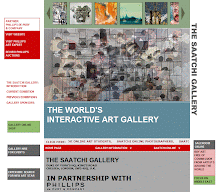Art takes its origins from a more or less stressed distance between its manifestations and reality, through the assumption of artificial shapes
that transcend the natural ones:
a picture, a poetry or a musical piece are always
an added construction that can overcome
the borderlines of contingent reality.
In the conception of the work of art, modern age creates a gap with the natural events.
If we look at the young "prostitute" Olympia of Manet, we notice that the author, by setting aside every emotional involvment, paints her in the way painters of the previous century would have painted a nude of noblewoman.
The work of art carries on the process of outdistancing which will become one of
the characteristics of contemporary art,
and which is regulated from what we can define
the "principle of indifference".
In the same way, the "Bottle Dryer" of Duchamp undertakes a revolutionary and epochal role.
How is it possibile that a normal tool of
everyday life can become a work of art?
Duchamp simply asks himself: "What is a work of art? If I took a bottle dryer from a wine merchant and put it in a gallery, would it be a work of art?"
Yes because the above mentioned bottle dryer would undergo what the surrealist movement
calls a "shock", a translation of reality:
that object is not used anymore to dry bottles
but it becomes a group of shapes that takes
a function alternative to the original one.
The anthropologist Lévi-Strauss, basing himself
on the assumption that usually someone visits
an art gallery to see works of art and not to drain bottles of wines for free, states that the fact of finding himself face to face to an object like this – dark and bristling with arms –
may let him be in awe of it.
This object, in fact, is not anymore what he has been built for, but becomes a kind of ghost,
an element that suggests something else,
and for this reason, gives rise to different feelings.
If we look at the young "prostitute" Olympia of Manet, we notice that the author, by setting aside every emotional involvment, paints her in the way painters of the previous century would have painted a nude of noblewoman.
The work of art carries on the process of outdistancing which will become one of
the characteristics of contemporary art,
and which is regulated from what we can define
the "principle of indifference".
In the same way, the "Bottle Dryer" of Duchamp undertakes a revolutionary and epochal role.
How is it possibile that a normal tool of
everyday life can become a work of art?
Duchamp simply asks himself: "What is a work of art? If I took a bottle dryer from a wine merchant and put it in a gallery, would it be a work of art?"
Yes because the above mentioned bottle dryer would undergo what the surrealist movement
calls a "shock", a translation of reality:
that object is not used anymore to dry bottles
but it becomes a group of shapes that takes
a function alternative to the original one.
The anthropologist Lévi-Strauss, basing himself
on the assumption that usually someone visits
an art gallery to see works of art and not to drain bottles of wines for free, states that the fact of finding himself face to face to an object like this – dark and bristling with arms –
may let him be in awe of it.
This object, in fact, is not anymore what he has been built for, but becomes a kind of ghost,
an element that suggests something else,
and for this reason, gives rise to different feelings.
This suggestion, together with a more complex reflexion that detaches itself from the classical interpretation of the work of art, shows that
the decontestualization of an object may create
a work of art.
the decontestualization of an object may create
a work of art.
We may ask ourselves: what has all of this to do
with the materiality of the work of art?
But most of all: can we interpret history of art using
as main criteria the vision of something that doesn't exist, that cannot be seen, something that the work of art just evokes, recognizing in it the opponent function of the author in relation to the dominant values of every age?
Though been dominated by materialism,
nowadays we live in an immaterial world:
we buy symbols, not products, and we consume virtual entertainement.
Also history of art of last decades,
with the exponential development of digital, highlights the passage to more and more
with the materiality of the work of art?
But most of all: can we interpret history of art using
as main criteria the vision of something that doesn't exist, that cannot be seen, something that the work of art just evokes, recognizing in it the opponent function of the author in relation to the dominant values of every age?
Though been dominated by materialism,
nowadays we live in an immaterial world:
we buy symbols, not products, and we consume virtual entertainement.
Also history of art of last decades,
with the exponential development of digital, highlights the passage to more and more
dematerialized shapes.
The same idea of aesthetich event theorized
by H.G. Gadamer mainteins that the work of
art doesnt's exist thank to its 'materialità',
but thanks to the immaterial processes of information and interpretation which
the dialectics between the finite shape
and what it trascends involves.
We can add to this considerations also the current developments of applied sciences,
in which the democristian assumption of
a "full void" is substituted by a "tingling void"
filled with annihilation and creations of
"virtual" particles.
The physical reality in which we live
is not "complete", or in a better way,
is filled with elements which are difficult to entrust with a status of existence, unless we prepare ourselves – which we are willing to do –
to another idea of reality and materialità.
The same idea of aesthetich event theorized
by H.G. Gadamer mainteins that the work of
art doesnt's exist thank to its 'materialità',
but thanks to the immaterial processes of information and interpretation which
the dialectics between the finite shape
and what it trascends involves.
We can add to this considerations also the current developments of applied sciences,
in which the democristian assumption of
a "full void" is substituted by a "tingling void"
filled with annihilation and creations of
"virtual" particles.
The physical reality in which we live
is not "complete", or in a better way,
is filled with elements which are difficult to entrust with a status of existence, unless we prepare ourselves – which we are willing to do –
to another idea of reality and materialità.
Immaterialism aims to be exactely this:
a kind of new Fibonnacci's Code which
interprets history of art in a new way,
revealing the contradictions and the different interpretation, taking on the research,
and so the doubt, as guide, and immaterial values
as main factors setting up an order
both ancient and contemporary.
Promoting the awareness of infinite potentials
of the immaterial and showing the ability of art
of filling up the gap between reality and ideal
is the historical task of our generation,
and the NY BIENNALE ART means to be
the Manifesto of this philosophy.
a kind of new Fibonnacci's Code which
interprets history of art in a new way,
revealing the contradictions and the different interpretation, taking on the research,
and so the doubt, as guide, and immaterial values
as main factors setting up an order
both ancient and contemporary.
Promoting the awareness of infinite potentials
of the immaterial and showing the ability of art
of filling up the gap between reality and ideal
is the historical task of our generation,
and the NY BIENNALE ART means to be
the Manifesto of this philosophy.






















